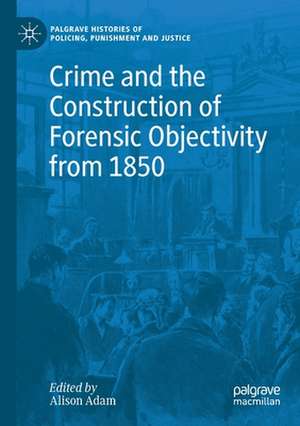Crime and the Construction of Forensic Objectivity from 1850: Palgrave Histories of Policing, Punishment and Justice
Editat de Alison Adamen Limba Engleză Paperback – 22 dec 2020
| Toate formatele și edițiile | Preț | Express |
|---|---|---|
| Paperback (1) | 998.19 lei 6-8 săpt. | |
| Springer International Publishing – 22 dec 2020 | 998.19 lei 6-8 săpt. | |
| Hardback (1) | 1003.38 lei 6-8 săpt. | |
| Springer International Publishing – 9 dec 2019 | 1003.38 lei 6-8 săpt. |
Preț: 998.19 lei
Preț vechi: 1217.31 lei
-18% Nou
Puncte Express: 1497
Preț estimativ în valută:
191.06€ • 207.61$ • 160.60£
191.06€ • 207.61$ • 160.60£
Carte tipărită la comandă
Livrare economică 21 aprilie-05 mai
Preluare comenzi: 021 569.72.76
Specificații
ISBN-13: 9783030288396
ISBN-10: 3030288390
Pagini: 315
Ilustrații: XVI, 315 p. 10 illus.
Dimensiuni: 148 x 210 mm
Greutate: 0.4 kg
Ediția:1st ed. 2020
Editura: Springer International Publishing
Colecția Palgrave Macmillan
Seria Palgrave Histories of Policing, Punishment and Justice
Locul publicării:Cham, Switzerland
ISBN-10: 3030288390
Pagini: 315
Ilustrații: XVI, 315 p. 10 illus.
Dimensiuni: 148 x 210 mm
Greutate: 0.4 kg
Ediția:1st ed. 2020
Editura: Springer International Publishing
Colecția Palgrave Macmillan
Seria Palgrave Histories of Policing, Punishment and Justice
Locul publicării:Cham, Switzerland
Cuprins
1. Crime And The Construction Of Forensic Objectivity: Introduction, Alison Adam.- 2.Bodies In The Bed: English Crime Scene Photographs As Documentary Images, Amy Helen Bell.- 3. Murder In Miniature: Reconstructing The Crime Scene In The English Courtroom, Alexa Neale.- 4. The Biggar Murder: ‘A Triumph For Forensic Odontology’, Alison Adam.- 5. Making Forensic Evaluations – Forensic Objectivity In The Swedish Criminal Justice System, Corinna Kruse.- 6. The Police Surgeon, Medico-Legal Networks And Criminal Investigation In Victorian Scotland, Kelly-Ann Couzens.- 7. ‘13 Yards Off The Big Gate And 37 Yards Up The West Walls’. Crime Scene Detection In Mid-Nineteenth Century Newcastle Upon Tyne, Clare Sandford-Couch And Helen Rutherford.- 8. The Construction Of Forensic Knowledge In Victorian Yorkshire: Dr Thomas Scattergood And His Casebooks, 1856–1900, Laura Sellers And Katherine D. Watson.- 9.Reporting Violent Death: Networks Of Expertise And The Scottish Post-Mortem, Nicholas Duvall.- 10. Detecting The Murderess: Newspaper Representations Of Women Convicted Of Murder In New York, London And Ireland, 1880-1914, Rian Sutton And Lynsey Black.- 11.‘Children’s Lies’: The Weimar Press As Psychological Expert In Child Sex Abuse Trials, Heather Wolffram.- 12. Murder Cases, Trunks And The Entanglement Of Ethics: The Preservation And Display Of Scenes Of Crime Material, Angela Sutton-Vane.
Notă biografică
Alison Adam is Professor of Science Technology and Society in the Cultural, Communication and Computing Research Institute at Sheffield Hallam University, UK. She has worked at Lancaster University, UMIST and the University of Salford as well as spending a number of years in industry prior to her academic career. Her research has been located in science and technology studies over a period of nearly forty years.
Textul de pe ultima copertă
This book approaches crime history through a detailed analysis of the ways in which forensic objectivity was constructed in relation to murder in the UK, and elsewhere, between the mid-nineteenth and twentieth centuries. This collection is interdisciplinary, with authors drawn from law, history, sociology and science and technology studies. It’s aim is to show how domestic, gendered and ethical knowledges were inextricably interwoven into expert knowledge, making what was taken to be objective knowledge of the crime and criminal: ‘forensic objectivity’. Each chapter addresses the question of forensic objectivity in different ways. Visual information is a vital part of the making of such objectivity and the use of photography in capturing and creating objectivity became increasingly important over the period covered by the proposed work. By centring the collection in the UK (but with some important international case studies for comparative purposes), over a crucial century for the concepts it explores, this essential title demonstrate the ways in which medical, policing and other expert knowledge changed rapidly over the course of 100 years.
Caracteristici
Uses murder cases to explore forensic objectivity Ties in with developing interest in crime scenes and scientific forensic analysis Appeals to those interested in criminology, history, policing, forensic science and law



